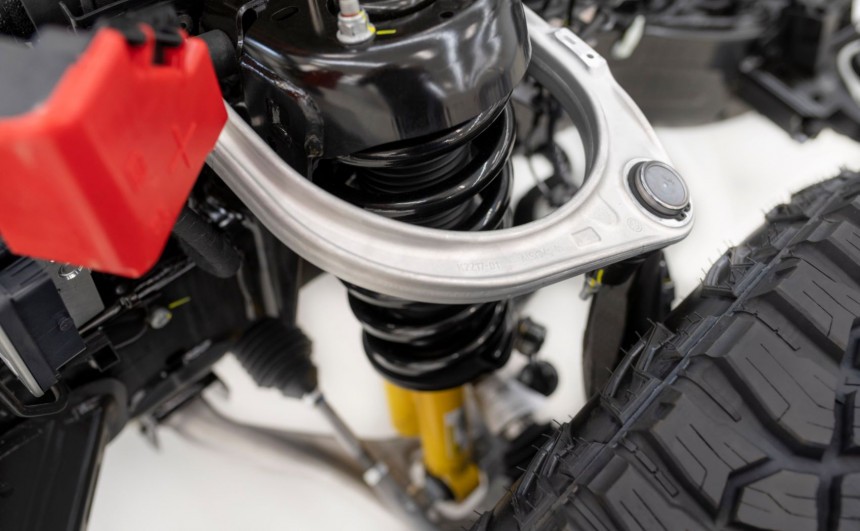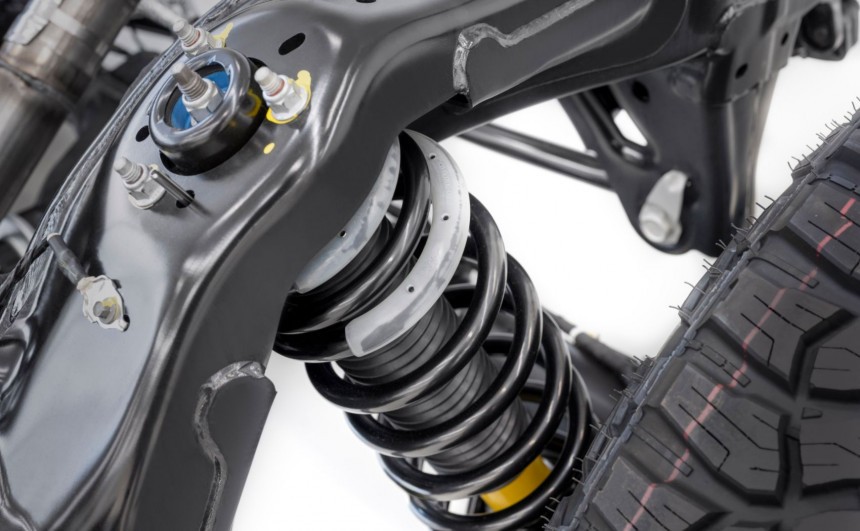At this year’s Woodward Dream Cruise, an event sponsored by the Blue Oval, the company showcased the Bronco’s High-Performance Off-Road Stability Suspension (HOSS) system. Inspired by Baja trophy trucks, it was engineered with the aim of making the revived 4x4 icon the most capable vehicle in its segment.
After a 25-year hiatus, Ford has finally released a new breed of Broncos into the wild. Intending to deliver the most capable American-built off-road machine, the company says it developed the body-on-frame SUV with the help of valuable input from the off-road community, which demanded more comfort and control without compromising all terrain-conquering abilities.
For that, a lighter, more agile suspension system dubbed HOSS was designed. Showcased at the aforementioned event, where the Blue Oval came with a fully assembled rolling chassis, the system provides pitch and roll control comparable to contemporary trophy trucks.
According to Ford engineers, it all starts with the second-generation Ford T-6 chassis that features an independent front suspension with forged twin aluminum alloy A-arms and long-travel coil-over springs inspired by the setup found on the F-150 Raptor. The main advantages of this configuration are the reduction of unsprung front axle weight (up to 20% over current solid-axle designs) and the ability to employ a rack-and-pinion steering system.
On one hand, a lower unsprung axle weight means that the tires should spend more time planted to the ground, improving ride comfort, especially when speeding over uneven surfaces. On the other hand, the rack-and-pinion steering offers more precision, better on-center steering, and reduced steering wheel kickback when compared to recirculating-ball systems. Moreover, it includes a three-mode electronic assist which enables the driver to change the steering configuration according to the surrounding terrain.
On the more capable Sasquatch Package and Badlands trim, the HOSS system parts ways with the standard Hitachi dampers in favor of long-travel position-sensitive Bilstein variants. Developed exclusively for the new Bronco, they come with end-stop control valves (ESCV) which increase ride height and improve comfort in the most challenging conditions. The Badlands Bronco also comes with a front semi-active hydraulic stabilizer bar that can electronically disconnect and reconnect, improving articulation when navigating through rugged surfaces.
At the rear, the HOSS system features a five-link 220-millimeter (8.6-inch) Dana 44 Advantek solid axle with progressive rate coil-over springs which Ford states is balanced for optimal payload capacity. With no stabilizer bar and the coils and dampers placed as outward as possible, stability and articulation are greatly improved. On the models mentioned above, the Bilstein dampers provide even greater rear pitch control at high speeds and better articulation when crawling over difficult obstacles at lower speeds.
The HOSS is undoubtedly the most impressive feature of the Bronco and played an important role in persuading many Wrangler owners to switch sides and order Ford’s new off-roader.
The system can also be found on the Bronco Sport crossover SUV, albeit in a different configuration. At the front, all trims use independent MacPherson struts with coil springs, a stabilizer bar, and twin-tube hydraulic gas-pressurized shocks. A similar setup is present at the rear where independent double lateral link semi-trailing arms are also paired with coil springs, a stabilizer bar, and monotube shocks.
On the range-topping Badlands and First Edition models, hydraulic rebound stops were fitted to increase control at the end stop and enhance comfort on rough terrain. These models also get specially tuned 46-mm diameter shocks, longer springs, and sturdier anti-roll bars for improved off-road capability.
To conclude, HOSS is the acronym that is set to describe the suspension systems used by the revived Bronco brand going forward and Ford hopes it will become synonymous with off-road excellence. It will be interesting to see what future models will offer but, in the meantime, both the Bronco and Bronco Sport can be ordered and enjoyed by North American customers.
For that, a lighter, more agile suspension system dubbed HOSS was designed. Showcased at the aforementioned event, where the Blue Oval came with a fully assembled rolling chassis, the system provides pitch and roll control comparable to contemporary trophy trucks.
According to Ford engineers, it all starts with the second-generation Ford T-6 chassis that features an independent front suspension with forged twin aluminum alloy A-arms and long-travel coil-over springs inspired by the setup found on the F-150 Raptor. The main advantages of this configuration are the reduction of unsprung front axle weight (up to 20% over current solid-axle designs) and the ability to employ a rack-and-pinion steering system.
On the more capable Sasquatch Package and Badlands trim, the HOSS system parts ways with the standard Hitachi dampers in favor of long-travel position-sensitive Bilstein variants. Developed exclusively for the new Bronco, they come with end-stop control valves (ESCV) which increase ride height and improve comfort in the most challenging conditions. The Badlands Bronco also comes with a front semi-active hydraulic stabilizer bar that can electronically disconnect and reconnect, improving articulation when navigating through rugged surfaces.
At the rear, the HOSS system features a five-link 220-millimeter (8.6-inch) Dana 44 Advantek solid axle with progressive rate coil-over springs which Ford states is balanced for optimal payload capacity. With no stabilizer bar and the coils and dampers placed as outward as possible, stability and articulation are greatly improved. On the models mentioned above, the Bilstein dampers provide even greater rear pitch control at high speeds and better articulation when crawling over difficult obstacles at lower speeds.
The system can also be found on the Bronco Sport crossover SUV, albeit in a different configuration. At the front, all trims use independent MacPherson struts with coil springs, a stabilizer bar, and twin-tube hydraulic gas-pressurized shocks. A similar setup is present at the rear where independent double lateral link semi-trailing arms are also paired with coil springs, a stabilizer bar, and monotube shocks.
On the range-topping Badlands and First Edition models, hydraulic rebound stops were fitted to increase control at the end stop and enhance comfort on rough terrain. These models also get specially tuned 46-mm diameter shocks, longer springs, and sturdier anti-roll bars for improved off-road capability.
To conclude, HOSS is the acronym that is set to describe the suspension systems used by the revived Bronco brand going forward and Ford hopes it will become synonymous with off-road excellence. It will be interesting to see what future models will offer but, in the meantime, both the Bronco and Bronco Sport can be ordered and enjoyed by North American customers.




















